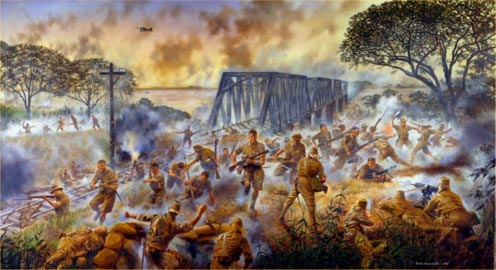
"The Battle of Sittang Bridge, Burma, February 1942"
Ref: DR031
by David Rowlands
Image Size 58 x 38 cm
In December 1941, Japan entered the Second World War and invaded Southern Burma. 17th Indian Infantry Division withdrew to the Sittang River to prevent the Japanese reaching the bridge first, which would have allowed them free access to Rangoon. 2nd Bn The Duke of Wellington's Regiment was rushed from India to join the rearguard.
The river, spanned by the railway bridge, was fast-flowing and nearly 1000 yards wide. The bridge was prepared for demolition. Troops mainly from the Indian Army were defending the bridgehead, having suffered severe casualties during a fighting retreat over many days. By 22nd February the Divisional commander decided that he had little choice but to order the demolition of the bridge, knowing that two-thirds of his Division would be stranded on the far bank.
As the two central spans of the bridge were blown, the exhausted troops continued fighting to prevent the Japanese securing the bridgehead. This allowed many troops to continue to cross the bridge with the aid of ropes, and rafts made from anything that would float. Others had to swim. The demolition of the bridge was the greatest disaster in the epic fighting retreat of the small, outnumbered British force in Burma, which covered nearly 1,000 miles in three and a half months.
Mr George Borwell, a former Gurkha officer, invited me to a meeting at RHQ The Duke of Wellington's Regiment in Halifax, where I was introduced to some of the survivors of the fighting. These included Bill Norman, Bill Townend and Dennis Mitchell. I asked them many questions about their weapons, equipment and other details which would enable me to paint the scene accurately. Other survivors, such as Pip Moran (who was the adjutant of 2 DWR) and Major Dickie Day, I was able to interview by phone.
Major Bruce Kinloch MC of 3rd Queen Alexandra’s Own Gurkha Rifles took part in the final counter-attack at the bridgehead, and he described to me dramatic events of courage and endurance. I have depicted Gurkhas and soldiers of The Dukes charging the Japanese at the edge of the jungle. In the left distance others are treating the wounded on the river bank, and trying to make flimsy bamboo rafts. A Japanese bomber harasses their efforts. Wartime Japanese photographs of the bridge, and photos taken by Bruce when he visited the location in 1995, enabled me to paint the landscape accurately.
